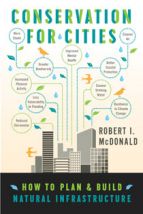Conservation for Cities

Conservation for Cities by Robert McDonald widens the traditional concept of conservation, as biodiversity protection, and introduces it as a tool for using nature to improve the lives of city dwellers. His book is based on the idea that nature is imperative to cities’ ability to survive and thrive. Furthermore, because this century will see the fastest urban growth so far in history and risk severing vital bonds between cities and nature, attention to these bonds is necessary. In light of urban growth and subsequent requirements for new infrastructure, McDonald asks what role natural infrastructure can play to meet these challenges. Furthermore, how can cities identify those ecosystem services that are most important, and map and economically quantify these?
This book is a practical guide aimed at urban planners, landscape architects, and conservation practitioners. “Rather than focusing on how to protect nature from cities”, McDonald claims, the book “is about how to protect nature for cities”. This is principally through the avenue of natural infrastructure to ensure or enhance ecosystem service provision.
Following the introduction, Chapter 2 presents McDonald’s framework for how to plan and implement natural infrastructure projects for the conservation of cities. His framework is made up of six stages, the first two of which (defining the problem and taking inventory) he describes in detail in this chapter. McDonald then explains how Chapters 3 to 12 help practitioners work through the remaining four stages by discussing specific ecosystem services (page 24).
The 10 key ecosystem services in cities that McDonald identifies include: drinking water (Chapter 3); stormwater mitigation (Chapter 4); flood mitigation (Chapter 5); coastal protection (Chapter 6); shade (Chapter 7); air purification (Chapter 8); aesthetic beauty (Chapter 9); parks for health and recreation (Chapter 10); parks for mental health (Chapter 11); and biodiversity (Chapter 12). These chapters follow a general pattern: they open with the case study of a city realizing the value of a particular ecosystem service, they present best available tools for mapping and valuing ecosystem services, and they end with a discussion of how the case study city and others have successfully set up natural infrastructure projects. According to McDonald, each chapter addresses a single ecosystem service not because it should be looked at in isolation, but because in practice, planning and legislation tend to focus on individual key ecosystem services (page 17).
Chapter 13 concludes the book by bringing these chapters together – in particular by revealing how cities can create one coherent vehicle by merging information and programmes from disparate ecosystem services. Here McDonald suggests that cities consider ecosystem services together, either thematically or by habitat (page 233). McDonald also reminds the reader that his focus on ecosystem services links back to his aim to illustrate practical means of using nature to improve people’s lives, and ultimately, taking all the book’s chapters together, to use nature to build a more resilient, thriving city.
Book note prepared by Hannah Keren Lee
Search the Book notes database
Our Book notes database contains details and summaries of all the publications included in Book notes since 1993 - with details on how to obtain/download.
Use the search form above, or visit the Book notes landing page for more options and latest content.
For a searchable database for papers in Environment and Urbanization, go to http://eau.sagepub.com/

